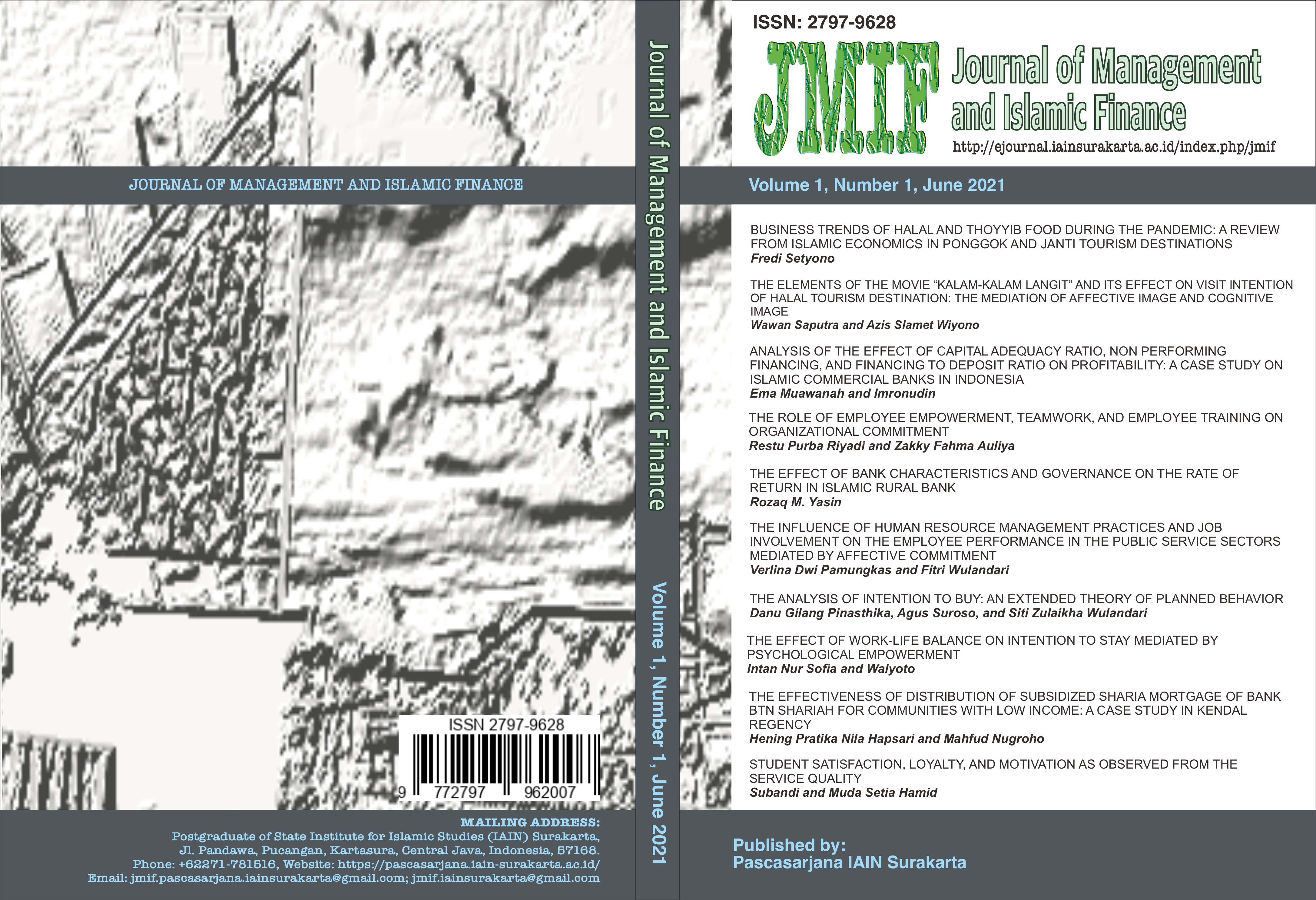THE EFFECT OF BANK CHARACTERISTICS AND GOVERNANCE ON THE RATE OF RETURN IN ISLAMIC RURAL BANK
DOI:
https://doi.org/10.22515/jmif.v1i1.3474Abstract
The difference in profit sharing on investment funds placed by customers and shareholders can create agency problems. This study aims to analyze the effect of bank characteristics and governance on the rate of return on investment received by depositors and shareholders as the main investors in the operations of the Islamic Rural Bank. This study used panel data from 10 Islamic Rural Bank in the Special Region of Yogyakarta from 2013 to2020. The results showed that all bank characteristic proxies, namely financing growth, financing structure, efficiency, and financing quality significantly affected the rate of return received by depositors and shareholders, except for the efficiency variable which did not significantly affect the rate of return on investment for depositors. Islamic Rural Bank governance structure needs to pay attention to the ownership ratio, capital adequacy ratio, and the effectiveness of supervision by the Sharia Supervisory Board to maintain a competitive return on investment so that it is attractive to both depositors and shareholders.
Downloads
References
Abdul-Rahman, A., Abdul Latif, R., Muda, R., & Abdullah, M. A. (2014). Failure and potential of profit-loss sharing contracts: A perspective of New Institutional, Economic (NIE) Theory. Pacific-Basin Finance Journal, 28, 136–151. https://doi.org/10.1016/j.pacfin.2014.01.004
Ahmed, H. (2002). A Microeconomic Model of an Islamic Bank (Issue 59). Islamic Development Bank, Islamic Research and Training Institute.
Amelia, E., & Hardini, E. F. (2017). Determinant of Mudharabah Financing: A Study at Indonesian Islamic Rural Banking. Etikonomi, 16(1), 43–52. https://doi.org/10.15408/etk.v16i1.4638
Amri, A., & Oviza, Y. C. (2018). Analisis Risiko dan Pengembalian Hasil Terhadap Pembiayaan Mudarabah Pada Bank Pembiayaan Rakyat Syariah (BPRS). AKBIS, 141–150.
Ardana, Y., & Wulandari, W. (2018). Tingkat Suku Bunga, Kinerja Keuangan, dan Bagi Hasil Deposito Pada Perbankan Syariah. Esensi: Jurnal Bisnis Dan Manajemen, 8(2), 177–186. https://doi.org/10.15408/ess.v8i2.8392
Arfiani, L. R., & Mulazid, A. S. (2017). Analisis Faktor-Faktor Yang Mempengaruhi Tingkat Bagi Hasil Simpanan Mudharabab Pada Bank Umum Syariah Indonesia Studi Kasus Pada Bank Umum Syariah di Indonesia Periode 2011-2015. Iqtishodia Jurnal Ekonomi Dan Perbankan Syariah, 4.
Fama, E. F. (1980). Agency Problems and the Theory of the Firm. Journal of Political Economy, 88(2), 288–307.
Hamza, H. (2016). Does Investment Deposit Return in Islamic Banks Reflect PLS Principle. Borsa Istanbul Review, 16(1), 32–42.
Hasanah, H., Azam Achsani, N., Ascarya, A., & Siregar, H. (2013). Displaced commercial risk: Empirical analysis on the competition between conventional and islamic banking systems in Indonesia. American-Eurasian Journal of Sustainable Agriculture, 7(4), 405–412.
Ismail, A. G. b., & Tohirin, A. (2010). Islamic law and finance Humanomics, Vol. 26 No. 3, pp. 178-199. Humanomics, 26(3), 178–199.
Jensen, M. C., & Meckling, W. H. (1976). Theory of The Firm: Managerial Behaviour, Agency Cost and Ownership Structure. Journal of Financial Economics 3 (1976) 305-360, 3. https://doi.org/10.1177/0018726718812602
Novianti, N., Badina, T., & Erlangga, A. (2016). Analisis pengaruh Return On Asset (ROA), Biaya Operasional Terhadap Pendapatan Operasional (BOPO), Suku Bunga, Financing To Deposits Ratio (FDR) Dan Non Performing Financing (NPF) Terhadap Tingkat Bagi Hasil Deposito Mudharabah (Studi Empiris pada Bank UM. Esensi: Jurnal Bisnis Dan Manajemen, 5(1), 65–86. https://doi.org/10.15408/ess.v5i1.2333
Nur, M. I., & Nasir, M. (2014). Pengaruh Kinerja Keuangan Terhadap Tingkat Bagi Hasil Deposito Mudharabah Dan Tingkat Pengembalian Ekuitas Pada Bank Umum Syariah Di Indonesia. Diponegoro Journal of Accounting, 3, 266–278.
Ramlan, H., & Adnan, M. S. (2016). The Profitability of Islamic and Conventional Bank: Case Study in Malaysia. Procedia Economics and Finance, 35(October 2015), 359–367. https://doi.org/10.1016/s2212-5671(16)00044-7
Srairi, S. (2013). Ownership structure and risk-taking behaviour in conventional and Islamic banks: Evidence for MENA countries. Borsa Istanbul Review, 13(4), 115–127. https://doi.org/10.1016/j.bir.2013.10.010
Downloads
Published
Issue
Section
Citation Check
License
Copyright (c) 2021 Journal of Management and Islamic Finance

This work is licensed under a Creative Commons Attribution-ShareAlike 4.0 International License.
Authors who publish with this journal agree to the following terms:
- Authors retain copyright and grant the journal right of first publication with the work simultaneously licensed under a Creative Commons Attribution License that allows others to share the work with an acknowledgement of the work's authorship and initial publication in this journal.
- Authors are able to enter into separate, additional contractual arrangements for the non-exclusive distribution of the journal's published version of the work (e.g., post it to an institutional repository or publish it in a book), with an acknowledgement of its initial publication in this journal.
- Authors are permitted and encouraged to post their work online (e.g., in institutional repositories or on their website) prior to and during the submission process, as it can lead to productive exchanges, as well as earlier and greater citation of published work.






